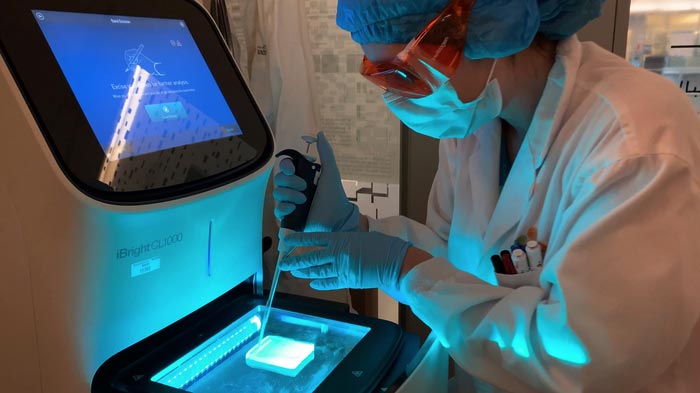Studying the genes behind surplus X chromosomes

Veronica Astro (pictured) and a team of KAUST bioscientists used stem cell analyses to improve understanding of the development of surplus X chromosomes in newborn males.
Credit: © 2022 KAUST
One in every 500 to 1,000 males are born with one or more extra X chromosomes, leading to a wide range of progressing symptoms with each extra chromosome, including infertility, enlarged breasts, osteoporosis, diabetes, heart abnormalities, intellectual disability and cancer. Now, KAUST scientists have used stem cells, reprogrammed from people with this condition, to improve understanding of how it develops.
People born as males typically have one X and one Y chromosome, whereas females have two X chromosomes. One of the two X chromosomes in females is usually inactivated, except for a small number of “escape” genes. X inactivation also happens in males born with one (Klinefelter syndrome) or more (higher grade sex chromosome aneuploidies, or HGAs) extra X chromosomes. But this still leaves the extra escape genes.
“Scientists have never focused on which genes are responsible for the plethora of features in Klinefelter syndrome and HGAs,” says research scientist Veronica Astro.
“We generated the largest cohort of induced pluripotent stem cells derived from patient fibroblasts to study the effects of having extra copies of the X chromosome in males,” explains Astro. “We also took advantage of KAUST’s cutting-edge technologies to compare gene expression between these and healthy stem cells to identify the genes that are aberrantly expressed in this genetic condition.”
The researchers showed most escape genes were found in a region of the short arm of the X chromosome called pseudo-autosomal region 1 (PAR1). Eleven were linked to progressive severity of symptoms with each extra X chromosome. These genes largely remained active when the researchers programmed the stem cells to develop into pre-liver and pre-pancreas cells. Their activity was dosage-sensitive: it increased with an increasing number of X chromosomes in the cells.
To further test their stem cells, the researchers also examined differences in gene regulators called transcription factors and found that a protein called nuclear respiratory factor 1 (NRF1) was overexpressed in the stem cells with extra X chromosomes, with impacts on a gene called zinc finger protein X-linked (ZFX).
“Importantly, we generated the first ever described cellular platform of induced pluripotent stem cells with various degrees of X chromosome aneuploidies that can be exploited to study the consequences of gene overdosage in early embryogenesis,” says bioscientist Antonio Adamo, who led the study.
Further efforts should help reveal the mechanisms behind the characteristics seen in people with Klinefelter syndrome and HGAs. The stem cell platform could also be used to screen drugs for treating these conditions.
Adamo’s team are now differentiating induced pluripotent stem cells with varying degrees of X chromosome aneuploidies into disease-relevant cell types — like nerve, heart, pancreas and sperm cells — to study how extra X chromosomes impact different tissues.
Journal: Frontiers in Cell and Developmental Biology
DOI: 10.3389/fcell.2021.801597
Method of Research: Experimental study
Subject of Research: Cells
Article Title: Pseudoautosomal Region 1 Overdosage Affects the Global Transcriptome in iPSCs From Patients With Klinefelter Syndrome and High-Grade X Chromosome Aneuploidies
Article Publication Date: 3-Feb-2022
All latest news from the category: Life Sciences and Chemistry
Articles and reports from the Life Sciences and chemistry area deal with applied and basic research into modern biology, chemistry and human medicine.
Valuable information can be found on a range of life sciences fields including bacteriology, biochemistry, bionics, bioinformatics, biophysics, biotechnology, genetics, geobotany, human biology, marine biology, microbiology, molecular biology, cellular biology, zoology, bioinorganic chemistry, microchemistry and environmental chemistry.
Newest articles

High-energy-density aqueous battery based on halogen multi-electron transfer
Traditional non-aqueous lithium-ion batteries have a high energy density, but their safety is compromised due to the flammable organic electrolytes they utilize. Aqueous batteries use water as the solvent for…

First-ever combined heart pump and pig kidney transplant
…gives new hope to patient with terminal illness. Surgeons at NYU Langone Health performed the first-ever combined mechanical heart pump and gene-edited pig kidney transplant surgery in a 54-year-old woman…

Biophysics: Testing how well biomarkers work
LMU researchers have developed a method to determine how reliably target proteins can be labeled using super-resolution fluorescence microscopy. Modern microscopy techniques make it possible to examine the inner workings…





















